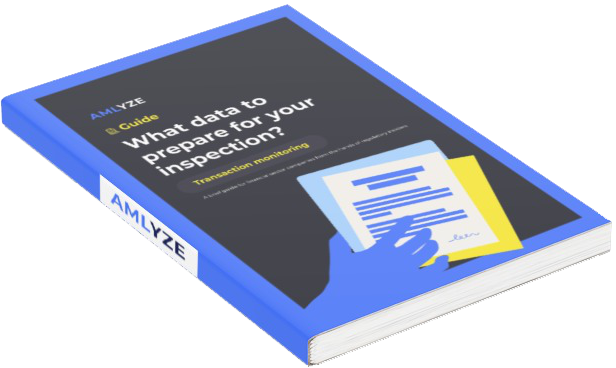In the dynamic and evolving financial sector, there has been an increased focus on robust anti-money laundering and counter-terrorist financing (AML/CTF) strategies, the cornerstone of which is the development of transaction monitoring rules and scenarios.
AMLYZE, a standout in Software as a Service expertise, not only delivers automated transaction monitoring solutions to detect suspicious patterns indicating financial crime. It also offers comprehensive guidance to financial institutions.
This includes assistance in implementing necessary rules. And advanced scenarios tailored to reflect financial institution’s business model and associated risks herein. It is our mission to develop, implement, and continually refine effective AML/CTF monitoring systems to combat money laundering and financial crimes. We have gathered a deep expertise on developing sophisticated transaction monitoring rules and scenarios. We have done this by cooperating with financial institutions, financial intelligence units and regulators.
The essence of AML/CTF transaction monitoring
Transaction monitoring is like the security guard of a financial institution’s system to prevent money laundering and terrorism financing. It keeps an eye on all the financial activity. Just to spot any suspicious behavior and alert on it for further analysis. Ultimately, a human analyst reviews these alerts and decide if the information additionally provided by the customer indeed supports the initial suspicion. And do they need to report the transaction to the financial intelligence unit as a possible criminal activity. Think of transaction monitoring like having a magical crystal ball that can predict if someone is trying to launder money. However all magic comes with a price. In this case, the price is the meticulously crafted transaction monitoring rules and scenarios.
The institution’s effort to predict the possible wrongdoing starts with the sourcing and analysis of the data. This includes customer’s profile, financial transactions, customer’s behavioral patterns when accessing financial services. Analysis of data might be automated and produce automatic alerts on suspicious or at least on unusual customer’s behavior. Detection of suspicious patterns and prediction if those patterns are associated with money laundering or even a predicate offense of money laundering (such as fraud, tax evasion, sanction evasion etc.) are initially based on automated transaction monitoring rules and scenarios.
Setting up the “magic transaction monitoring ball” to function effectively is no easy feat. It involves creating intelligent rules and scenarios that require a deep understanding of criminal tactics (typologies used for money laundering) and strong data engineering skills. These rules detect any unusual or suspicious patterns within the large volume of transactions being processed. If they detect an abnormal pattern, they trigger alerts to AML analysts for further investigation. It helps to uncover criminal activity and freeze suspicious assets before it’s too late.
Risk-based transaction monitoring
Law enforcement, financial intelligence units, and regulators typically identify and share patterns of money laundering, terrorism financing, and other financial crimes. They do this through various channels like supranational, national risk assessments, reports and dedicated feedback to institutions. However, it’s up to institutions to interpret and implement these patterns into specific transaction monitoring rules. Regulatory bodies often encourage a risk-based approach. They allow institutions to enhance basic rules with more sophisticated scenarios aligned with risks to better detect and prevent illicit activities.
The risk-based approach integrates various risk concepts that might be applied differently within transaction monitoring processes. We are of the opinion that the risk-based approach begins with the segmentation of customers. Categorizing customers into different risk groups allows the creation of tailored transaction monitoring rules. Those that address the specific risks associated with each group. Customer segmentation is crucial for profiling customers, enabling the identification of unusual transactions or patterns. It’s important to compare a customer against similar ones to detect abnormal behavior accurately.
In the end, transaction monitoring revolves around assessing transaction risk. Segmenting customers is the first step in the risk-based approach. And it can be further refined by employing various algorithms within the transaction monitoring rules to identify different aspects of transaction risk. Moreover, the transaction monitoring rules themselves may undergo risk scoring. So that to prioritize the investigation of alerts based on different rule sets.
Developing efficient monitoring rules
Looking for suspicious patterns can sometimes feel like searching for a needle in a haystack. And many AML analysts grapple with a high number of false positives caused by ineffective transaction monitoring rules. In financial institutions, AML departments operate within certain resource constraints. Therefore effective transaction monitoring rules and scenarios are essential not only for successful fight against crime, but also for efficient allocation of human resources for further analysis of alerts.
A transaction can appear unusual from various viewpoints, and transaction monitoring rules assess it from multiple angles. Certain rule algorithms analyze the account’s historical usage to identify any sudden deviations from established patterns. While others consider factors like transaction size and frequency within a specific timeframe. However, the challenge lies in determining whether these deviations are genuinely suspicious or simply reflect gradual fluctuations in transaction volume or seasonal variations. There are no one-size-fits-all solution. However, we might provide several suggestions on how to make transaction monitoring rules work more effectively.
Suggestions for effective transaction monitoring rules:
- Avoid on-size-fits-all approach, use customer risk segmentation. Apply for each customer risk segment specific rule set.
- Utilize data analytics for rule development. Comprehensive data analysis is essential for understanding patterns and trends within the institution’s client portfolio as well as individual client behavior.
- Utilize easily adaptable rule parameters within the system. These parameters should be flexible and capable of adjusting to evolving compliance requirements. Avoid rigid, hard-coded parameters, as parameterization should facilitate swift updates in response to shifts in risk profiles or system performance.
- Opt for dynamic rules over static fixed parameter rules to enhance effectiveness. Static thresholds (such as “create an alert when the amount exceeds a <fixed threshold>”) often lead to numerous false positives due to their rigid nature. Conversely, rules with automatic threshold adjustments are better equipped to detect unusual behavior with greater accuracy. These dynamic rules vary in complexity and yield fewer false positives. For instance, a rule like “alert when the amount exceeds two times the standard deviation for <specific risk segment> in the last x days” offers more nuanced detection capabilities.
- Merge rules into rule sets or scenarios to more accurately capture specific criminal typologies. While individual rules may not fully capture certain money laundering typologies on their own, combining them within a rule set or scenario can enhance detection capabilities. This approach allows for a more comprehensive analysis of transaction data and improves the identification of complex money laundering schemes.
- Carefully choose the rules for real-time transaction monitoring. To quickly identify and freeze transactions with a high risk of money laundering. However, freezing transactions without valid grounds could burden clients accessing financial services unnecessarily. It’s essential to consider which transaction monitoring rules will trigger the freezing of transactions or funds. And which will serve as indicators for retrospective client behavior review without immediate asset freezing.
- Backtesting isn’t just a buzzword or a regulatory checkbox; it’s a valuable tool. It’s used to verify if transaction monitoring rules yield expected results based on historical data.
The new trends in enhancing monitoring
The suggestions above are just a few basic tips and tricks. However, in an ideal scenario, artificial intelligence (AI) would function as an indispensable tool for detecting complex transaction patterns, promptly alerting to clear criminal typologies, and establishing an AML framework devoid of false positives. Every monitoring specialist cherish this goal. As AI continues to advance across various domains, it’s becoming evident that these methods may not suffice to address evolving threats in the criminal world. To better tackle such challenges, more comprehensive algorithms incorporating machine learning are necessary for transaction monitoring rule and scenario development.
AI and machine learning have permeated every realm of automation, including transaction monitoring. In an ideal scenario, AI would serve as an indispensable tool for detecting intricate transaction patterns. And for promptly alerting on clear criminal typologies. And, of course, for creating an AML realm with no false positives (a dream of every monitoring specialist).
Still in visionary stage
Replacing the human element in AML processes is an aspiration. But it remains largely in the visionary stage. Machine learning, AI, forecasting models (to name a few) rely heavily on the data. The data that is fed into the system and the data from the decisions are made then. Access to high-quality, comprehensive datasets is paramount for effectively training AI models.
These datasets should encompass various transaction types, customer profiles, historical patterns of suspicious activity, and decisions made by humans when alerted transactions were deemed suspicious or exhibited criminal patterns.
In essence, it’s akin to the proverb “it takes a village to raise a child,” translated into AI terms as “it takes a vast pool of data to educate an AI.” In the realm of suspicions and transactions, a public-private partnership (involving financial intelligence units collaborating with financial institutions) is instrumental in producing such datasets. And AMLYZE is the one, who is taking seriously the possibilities of this public-private partnerships might bring (yes, this is a spoiler for our future articles).
Evolution of technologies
AI has become a buzzword across various industries. But the reality is different. Many institutions are still grappling with enhancing their expertise in advanced analytics and implementing well-structured algorithms. Processes like robotization and backtesting automation, while seemingly straightforward, represent “new technological trends” for numerous institutions. Analytical software, such as that developed by SaaS, is already supporting analysts in data analysis and automating manual tasks.
The widespread adoption of instant payments into customers’ daily lives presents new technological challenges for an accelerated transaction monitoring processing. Implementing technologies that enable fast transaction processing for instant payments without compromising on the effectiveness of transaction monitoring checks will be critical in fostering the evolution of both the payment market and AML technologies.
Future directions with AMLYZE
Predictive analytics for proactive monitoring and behavioral pattern analysis for early detection are at the forefront of AMLYZE’s approach. Collaboration within the financial community for best practices and regulatory partnerships is essential for maintaining compliance excellence.
In an era where financial crime tactics are increasingly sophisticated, financial institutions must remain vigilant and adaptive. AMLYZE’s comprehensive approach to AML transaction monitoring rules not only aligns with regulatory demands but also fortifies against financial crimes. By integrating advanced technologies, promoting continuous learning, and fostering collaborative efforts, institutions can safeguard their operations and uphold the integrity of the global financial system.
Read more here about the basics of transaction monitoring and the key steps in the process.






